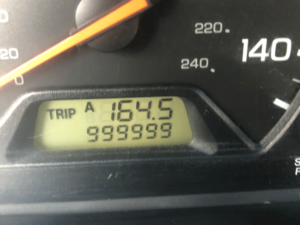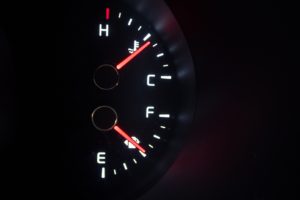
From time to time I will get into a conversation with a fellow motorist about how well their vehicle is or isn’t working. More specifically, these conversations are usually about how the engine is operating. One such conversation recently caught my attention. A nice lady that I met at a dealership told me that she knew her car was running well. I respectfully asked, “how do you know?” She replied, “because the check engine light is not on.”
To be honest I couldn’t fault her logic. In most drivers’ minds, if the check engine or service engine soon lights are not on, then there is not a problem. As someone in the industry, I know that it is not that simple.
My Experience with Fuel Efficiency
I drive a 2000 Honda Accord that my wife and I bought new. As a vehicle inspector, most of my days are spent going to dealerships and repair facilities all over Central North Carolina and Southern Virginia. With the amount of time that I spend on the road, it’s relatively easy for me to rack up the miles on my vehicle. There are currently over 1,000,000 miles on my car.

Even with my experience, I have no idea if my engine and its ancillary components are behaving like Honda’s engineers intended unless I connect some sort of diagnostic equipment to the vehicle. Having access to this equipment makes it easy for me to get a snapshot of the current condition of my engine and its management system.
On average, I fill up three to four times a week, so it’s easy to understand why I am big on making sure my engine and fuel management systems are running at an optimal level. I usually do an engine performance check on my car about once every other month, just to make sure everything is operating as it should be. Of course, this would be overkill for the average driver. Since I have access to the equipment, though, it’s relatively easy for me to check my car for any performance or fuel efficiency issues.
Gas Mileage is Critical

As I mentioned earlier, gas mileage per tank of fuel is really important to me. My Accord consistently gets between 440 and 460 miles out of a 15 gallon tank. That’s basically around 30 miles per gallon. When my fuel mileage drops under 440 miles per tank, I can usually trace the excessive fuel consumption back to the way I was driving, the topography, climate, etc. If the fuel efficiency drop is even more noticeable, I will take a closer to look to see if there is anything out of the ordinary going on.
The last two times my fuel economy dropped drastically, the culprits were mis-calibrated and lazy oxygen sensors, and a failing torque converter. The torque converter had an effect of roughly twenty five miles per tank, while the oxygen sensors decreased fuel efficiency by closer to thirty miles per tank of fuel. The oxygen sensors were relatively easy to fix, while the torque converter was considerably more expensive.
Why Engine Problems Aren’t Always Obvious
Most drivers may not be aware of a problem until there are obvious issues like a lack of power, sluggishness, higher than normal fuel consumption, or the dreaded check engine light that we mentioned earlier. Making it even more challenging, many newer cars are able to cover up and mask certain issues if a sensor, actuator or other component is approaching the lower or upper boundaries of their operating parameters. Said another way, modern vehicles are so good at compensating for problems with engine management system components that a change in idle quality and engine performance may not be easily noticeable.
By the way, most technicians will not check for potential engine performance problems unless the customer brings it to their attention. The free inspection that most repair facilities offer is a usually a visual inspection of the vehicle’s undercarriage, tires, engine compartment, etc.
Now, Back to the infamous check engine light. Most people may be thinking, “why would I bother if the check engine light is not on or there are no noticeable performance issues?”
Let’s take a closer look.
The Logic Behind the Light
Just because a warning light is not illuminated doesn’t mean everything is copacetic. Without making this post too technical, we need to understand why the check engine light is activated in the first place. The main reason that the engine’s computer decides to turn on the check engine light is for a real or perceived increase in engine related emissions. In simple terms, all manufacturers want the air coming into the engine to mix with the correct amount of fuel and efficiently burn that air/fuel mixture. When this happens, the exhaust makeup will be mainly water, carbon dioxide, and small amounts of oxygen, carbon monoxide and unburned fuel. The catalytic converter is in place to reduce the harmful emissions (carbon monoxide, unburned fuel, oxides of nitrogen) even further. If a sensor, actuator or other engine management system component is not working as the manufacturer intended, then the air and fuel mixture will not burn completely and emissions levels will increase. In this scenario, engine performance and fuel efficiency can also suffer.
An Ounce of Prevention
Depending on how much a person drives, the mileage and the age of the vehicle, my advice to motorists would be to have your vehicle checked out at least once or twice a year. For example, this could be when the vehicle is brought in for routine maintenance or, right before a road trip. As I mentioned earlier, a technician will typically not check for performance or fuel efficiency issues unless it is mentioned by the customer. Also, keep an eye on how many miles you typically go between having to refuel. Know what is “normal” for your vehicle. If there is a noticeable drop in fuel economy, then this is a good indicator that a closer look at the engine management system would be in order.
Taking these basic steps before you see a dreaded check engine light on your dashboard can help prevent seeing the light at all, and extend the life of your investment.
If you have concerns about your fuel efficiency or engine performance, contact me so we can discuss how I can help.
Happy driving!
